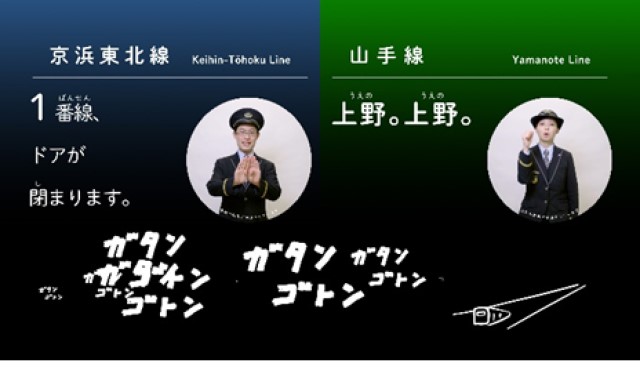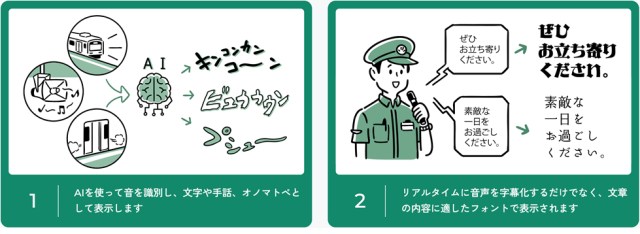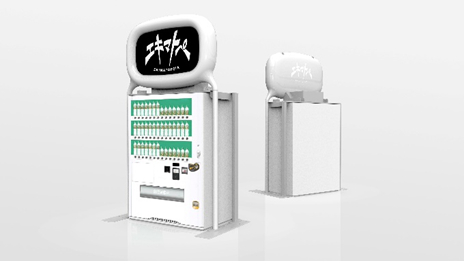
One of the most fun accessibility features you’ll ever see.
Train stations in Japan can be chaotic places full of rushing machinery, echoing chimes, and a steady stream of announcements. In no city is this more frequently true than the metropolis of Tokyo, where commuting can be especially daunting for the city’s many differently-abled people such as those in the deaf and hearing-impaired community.
And to make life a little easier for them IT giant Fujitsu has come up with Ekimatopeia.
▼ A news report about Ekimatopeia
Ekimatopeia consists of a large screen display posted on the train station’s boarding platform onto which manga-style onomatopoeic sounds are displayed. These sounds actually represent what an AI picks up through a microphone and interprets in real-time.
▼ A diagram of how Ekimatopeia works: It would be cool if it really were a giant brain with wires coming out of it, but that’s probably asking too much.
So, if a train were approaching the platform its clanking “gachan-gachan-gachan” sound would be splashed across the screen. If the train were slowing down to a stop, if an express was speeding through, or even if an alarm or horn sounded, it would all be visualized by words on the screen. Its rather detailed too, so that if a really nice train was gliding by, the screen would show a pleasing “hyuuuuuuuuu” and a slightly rougher one with a modified “byuuuuun.”
In addition, announcements by station staff are dictated on the screen and in the case of pre-recorded messages a sign language interpreter is also shown. The name “Ekimatopeia” comes from the Japanese word for station, “eki,” and a few syllables from the English word “onomatopoeia.”
▼ The eternal question: Is Ekimatopeia attached to a vending machine, or is a vending machine attached to Ekimatopeia?
Fujitsu got the idea from students at a school for deaf people who talked about how they felt when commuting to school by train. Some had said that they were scared because they don’t always notice the train as it approaches and that navigating the sometimes extremely complex stations would be easier with some guidance in sign language.
Project leader Tatsuya Honda said that when coming up with Ekimatopeia, they wanted to make something that not only addressed these problems but would also be fun for people with all types of hearing. “I’d be happy if people think about what kind of problems deaf people face,” said Honda, “and I’d be happy if we could become a kinder society.”
▼ A video on the creation of Ekimatopeia with English subtitles
I know I could just sit and gawk at Ekimatopeia for a long time, and it seems I’m not alone as online comments have shown near unanimous praise for it too.
“I want this to be actively adopted everywhere.”
“I love the style of fonts they use.”
“My daughter commutes to a school for the deaf and can’t know when delays occurs. She also can’t ask anyone because staff usually don’t know sing language, so this is very helpful.”
“That’s something we can be proud of having in Japan.”
“I want Ekimatope in all stations!”
“This is just the beginning to. It can get even better.”
“It’s like JoJo’s Bizarre Adventure.”
“The best part is that they made it fun. More technology needs to consider fun.”
At the moment, Ekimatopeia is only installed on the Keihin-Tohoku Line/Yamanote Line platform of JR Ueno Station in Tokyo, but Honda hopes that it becomes more widely adopted, perhaps even as a “Soramatopeia” version for use in airports. Considering its usefulness, popularity, and seemingly low-cost setup, it’s hard to imagine why this technology won’t spread throughout Japan, and maybe even beyond, in the future.
Source: Nikkei Shimbun, YouTube/日テレNEWS
Images: Fujitsu
● Want to hear about SoraNews24’s latest articles as soon as they’re published? Follow us on Facebook and Twitter!



 Robot-operated soba stand in Tokyo is too busy for its machine chef to keep up with
Robot-operated soba stand in Tokyo is too busy for its machine chef to keep up with Tokyo’s most popular park partially bans Pokémon GO in response to inconsiderate gamers
Tokyo’s most popular park partially bans Pokémon GO in response to inconsiderate gamers New app allows commuters to share info on train delays through Twitter
New app allows commuters to share info on train delays through Twitter Tokyo Metro adds platform display showing where least crowded parts of the next train will be
Tokyo Metro adds platform display showing where least crowded parts of the next train will be “No dogs allowed”: Why one service dog was refused entrance to these restaurants in Japan
“No dogs allowed”: Why one service dog was refused entrance to these restaurants in Japan How to order snacks on a Shinkansen bullet train in Japan
How to order snacks on a Shinkansen bullet train in Japan New Pokémon ice cream, dessert drinks, and cool merch coming to Baskin-Robbins Japan【Pics】
New Pokémon ice cream, dessert drinks, and cool merch coming to Baskin-Robbins Japan【Pics】 Japan’s new difficult-to-drink-from beer glass protects your liver, but it’s a brutal experience
Japan’s new difficult-to-drink-from beer glass protects your liver, but it’s a brutal experience Demon Slayer: Kimetsu no Yaiba gets new roller coaster attractions and food at Universal Studios Japan
Demon Slayer: Kimetsu no Yaiba gets new roller coaster attractions and food at Universal Studios Japan Burger King Japan suddenly adds Dr. Pepper and Dr. Pepper floats to its menu nationwide
Burger King Japan suddenly adds Dr. Pepper and Dr. Pepper floats to its menu nationwide High-fashion Totoro cuddle purse is like an elegant stroll in the forest【Photos】
High-fashion Totoro cuddle purse is like an elegant stroll in the forest【Photos】 Hello, cosmetics! Clinique teams up with Hello Kitty this summer for first-time collaboration
Hello, cosmetics! Clinique teams up with Hello Kitty this summer for first-time collaboration To combat declining birth rate, Japan to begin offering “Breeding Visas” to foreigners
To combat declining birth rate, Japan to begin offering “Breeding Visas” to foreigners Russian crocodile hospitalized after woman falls on it
Russian crocodile hospitalized after woman falls on it Starbucks Japan welcomes alpacas for cute summer drinkware line【Photos】
Starbucks Japan welcomes alpacas for cute summer drinkware line【Photos】 Nintendo history you can feel – Super NES, N64, and GameCube controllers become capsule toys
Nintendo history you can feel – Super NES, N64, and GameCube controllers become capsule toys “The most Delicious Cup Noodle in history” – Japan’s French Cup Noodle wins our heart【Taste test】
“The most Delicious Cup Noodle in history” – Japan’s French Cup Noodle wins our heart【Taste test】 Starbucks releases a cute Frappuccino and Unicorn Cake…but not in Japan
Starbucks releases a cute Frappuccino and Unicorn Cake…but not in Japan Kyoto Tower mascot termination reveals dark side behind cute Japanese characters
Kyoto Tower mascot termination reveals dark side behind cute Japanese characters McDonald’s Japan’s Soft Twist Tower: A phantom ice cream only sold at select branches
McDonald’s Japan’s Soft Twist Tower: A phantom ice cream only sold at select branches Yabai Ramen: What makes this Japanese ramen so dangerous?
Yabai Ramen: What makes this Japanese ramen so dangerous? Finally! Nintendo Japan expands Switch 8-bit controller sales to everybody, Online member or not
Finally! Nintendo Japan expands Switch 8-bit controller sales to everybody, Online member or not Japanese government wants to build luxury resorts in all national parks for foreign tourists
Japanese government wants to build luxury resorts in all national parks for foreign tourists 10 things you should buy at 7-Eleven in Japan
10 things you should buy at 7-Eleven in Japan Studio Ghibli releases anime heroine cosplay dresses that are super comfy to wear
Studio Ghibli releases anime heroine cosplay dresses that are super comfy to wear Woman charged for driving suitcase without a license in Osaka
Woman charged for driving suitcase without a license in Osaka Studio Ghibli unveils My Neighbour Totoro miniature house model
Studio Ghibli unveils My Neighbour Totoro miniature house model Kyoto experiencing problems with foreign tourists not paying for bus fares, but not on purpose
Kyoto experiencing problems with foreign tourists not paying for bus fares, but not on purpose Fighting mild hunger with a Japanese soda that turns into jelly in the stomach【Taste test】
Fighting mild hunger with a Japanese soda that turns into jelly in the stomach【Taste test】 Studio Ghibli’s Howl’s Moving Castle tapestry unveiled in Japan for first time
Studio Ghibli’s Howl’s Moving Castle tapestry unveiled in Japan for first time McDonald’s new Happy Meals offer up cute and practical Sanrio lifestyle goods
McDonald’s new Happy Meals offer up cute and practical Sanrio lifestyle goods Sales of Japan’s most convenient train ticket/shopping payment cards suspended indefinitely
Sales of Japan’s most convenient train ticket/shopping payment cards suspended indefinitely Sold-out Studio Ghibli desktop humidifiers are back so Totoro can help you through the dry season
Sold-out Studio Ghibli desktop humidifiers are back so Totoro can help you through the dry season Japanese government to make first change to romanization spelling rules since the 1950s
Japanese government to make first change to romanization spelling rules since the 1950s Foreigner’s request for help in Tokyo makes us sad for the state of society
Foreigner’s request for help in Tokyo makes us sad for the state of society Ghibli founders Toshio Suzuki and Hayao Miyazaki contribute to Japanese whisky Totoro label design
Ghibli founders Toshio Suzuki and Hayao Miyazaki contribute to Japanese whisky Totoro label design Doraemon found buried at sea as scene from 1993 anime becomes real life【Photos】
Doraemon found buried at sea as scene from 1993 anime becomes real life【Photos】 Tokyo’s most famous Starbucks is closed
Tokyo’s most famous Starbucks is closed Princesses, fruits, and blacksmiths: Study reveals the 30 most unusual family names in Japan
Princesses, fruits, and blacksmiths: Study reveals the 30 most unusual family names in Japan Vending machine makes commuters smile at Japanese train station
Vending machine makes commuters smile at Japanese train station Foreign travelers in Tokyo, other towns handing out flags, asking Japanese people to pay for them
Foreign travelers in Tokyo, other towns handing out flags, asking Japanese people to pay for them Platform 13½ set to open at Ueno Station in Tokyo
Platform 13½ set to open at Ueno Station in Tokyo Crabs take over electric signboard at Japanese train station
Crabs take over electric signboard at Japanese train station Commuter chaos at Shibuya Station after glass window breaks on door of crowded Japanese train
Commuter chaos at Shibuya Station after glass window breaks on door of crowded Japanese train “Can you drop a bomb on America?” Japanese man shocks commuters from tracks of busy train station
“Can you drop a bomb on America?” Japanese man shocks commuters from tracks of busy train station Shitty Shibuya – Dozens of human turds discovered on Tokyo train platform
Shitty Shibuya – Dozens of human turds discovered on Tokyo train platform Woman suffers burns after aluminium can explodes at Shinjuku Station
Woman suffers burns after aluminium can explodes at Shinjuku Station Japanese cheater learns why you should never try to lie to your train otaku girlfriend
Japanese cheater learns why you should never try to lie to your train otaku girlfriend Send a free drink to a friend with Japan’s newest coinless vending machines【Video】
Send a free drink to a friend with Japan’s newest coinless vending machines【Video】 22 February turned out to be a bad day for Tokyo train commuters, as freak delays showed
22 February turned out to be a bad day for Tokyo train commuters, as freak delays showed The smallest Family Mart in Japan closes down
The smallest Family Mart in Japan closes down Starbucks Japan opens first sign-language store in Tokyo
Starbucks Japan opens first sign-language store in Tokyo Buddhist metaverse “Teraverse” in development at Kyoto University, includes AI Buddha
Buddhist metaverse “Teraverse” in development at Kyoto University, includes AI Buddha Japanese Twitter users share a secret hiding on platform five at Akihabara Station
Japanese Twitter users share a secret hiding on platform five at Akihabara Station
Leave a Reply